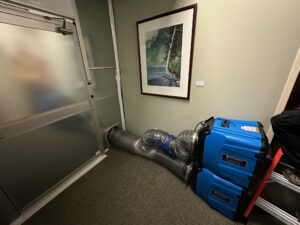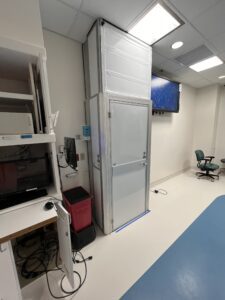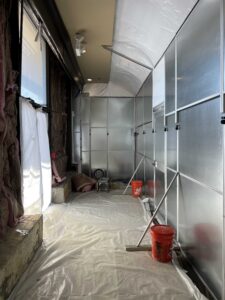How Does a Negative Air Pressure Room Work?
Negative air pressure rooms in healthcare, a.k.a. isolation rooms, are crucial, especially in pandemics or outbreaks. These rooms are critical in containing airborne particles and diseases and safeguarding patients and medical personnel. But what exactly does “negative air pressure” entail, and how do these rooms function to fulfill their vital role? Let’s learn about how a negative air pressure room works.
How Does a Negative Air Pressure Room Work?
Negative air pressure might sound ominous, but in principle it’s quite simple. In essence, it refers to a controlled environment where the air pressure within a confined space is maintained at a lower level than its surroundings. This disparity in pressure creates a pressure gradient, meaning when a door is open, air will flow from areas of higher pressure (outside the room) to areas of lower pressure (inside the room).
Because the room has lower air pressure, no air will flow outside the room when the door is opened, keeping the contaminated air inside the room. This fundamental concept forms the backbone of how negative air pressure rooms work.
Mechanics of a Negative Air Pressure Room:
A negative air pressure room functions by constantly expelling air from the room, preventing potentially contaminated air from escaping into adjacent spaces. The air being pumped outside of the contaminated room is cleaned and filtered before leaving the room to prevent contamination. This controlled airflow is achieved through a combination of specialized ventilation systems and meticulous design.
One of the primary objectives of negative air pressure rooms is to isolate airborne particles and pathogens within a confined space, minimizing the risk of transmission to other areas. This containment is particularly crucial in healthcare settings where infectious diseases pose a significant threat.
Here’s a more detailed explanation of how they accomplish this:
1. Containment of Airborne Pathogens:
Negative air pressure rooms are specifically engineered to maintain a pressure gradient that ensures air flows from areas of higher pressure (outside the room) to areas of lower pressure (inside the room). This constant inward airflow prevents contaminated air from escaping into adjacent spaces, thereby containing airborne pathogens within the room. ICRA is the standard process used for infection control when creating a negative air pressure room.
2. Ventilation System Design:
The ventilation system in a negative pressure room is designed to facilitate the desired airflow patterns. Typically, these rooms feature exhaust vents that continuously remove air from the room, creating negative pressure relative to the surrounding areas. This negative pressure environment confines the room’s airborne particles, including infectious agents.
3. Sealing and Airflow Control:
Negative air pressure rooms have sealed doors and windows to minimize air leakage and enhance containment effectiveness. Any potential gaps or openings that could compromise the integrity of the negative pressure environment are sealed. Additionally, adjustable vents and airflow regulators allow for precise control over the direction and velocity of airflow within the room, further optimizing containment efforts.
4. Filtration Systems:
Advanced filtration systems are integral components of negative air pressure rooms. These systems typically incorporate high-efficiency particulate air (HEPA) filters, which can efficiently capture airborne particles as small as 0.3 microns. HEPA filters effectively trap infectious agents, including bacteria, viruses, and other microorganisms, preventing them from circulating outside the room.
5. Air Exchange Rates:
The air exchange rate within a negative pressure room is carefully calibrated to maintain optimal air quality and containment. Higher air exchange rates facilitate more rapid removal of airborne contaminants, reducing the risk of accumulation within the room. Regular monitoring and adjustment of air exchange rates ensure that the room consistently maintains its negative pressure environment.
6. Personnel Protocols:
In addition to the technical aspects of room design and ventilation, strict protocols are established to govern the use of negative air pressure rooms. Healthcare personnel entering and exiting these rooms adhere to rigorous infection control practices, including personal protective equipment (PPE) such as masks, gowns, and gloves. In our past projects, we’ve used these measures to further minimize the risk of contamination and transmission of infectious agents.
7. Continuous Monitoring and Maintenance:
Continuous monitoring of air pressure differentials, temperature, humidity, and particle concentration is essential to ensure the ongoing effectiveness of negative air pressure rooms. Automated monitoring systems and sensors provide real-time data on air quality parameters, enabling prompt detection of deviations from desired conditions. Regular maintenance and servicing of ventilation systems and filtration components are critical to ensure optimal performance and reliability.
Types of Isolation Rooms:
Negative air pressure rooms are categorized into several classes, each tailored to specific requirements:
Class S: Designed for patients with highly contagious diseases like tuberculosis or measles, Class S rooms feature stringent airflow control and filtration systems.
Class P: These rooms are designated for patients with known or suspected airborne infections, providing a controlled environment to prevent the spread of pathogens.
Class N: Primarily utilized for immunocompromised patients, Class N rooms minimize the risk of exposure to airborne contaminants, helping to safeguard vulnerable individuals.
Class Q: Reserved for procedures that generate airborne contaminants, such as certain surgical interventions, Class Q rooms ensure a sterile environment by effectively managing airflow and filtration.
Conclusion
In conclusion, negative air pressure rooms represent a pinnacle of engineering ingenuity and medical innovation. These rooms play a pivotal role in mitigating the spread of airborne pathogens and safeguarding public health by harnessing the principles of airflow dynamics and advanced filtration technology. As we continue to navigate the complexities of infectious disease control, the significance of negative air pressure rooms in healthcare cannot be overstated. Their existence is a testament to Temporary Wall Systems’ unwavering commitment to protecting lives and preserving well-being in healthcare facilities.


